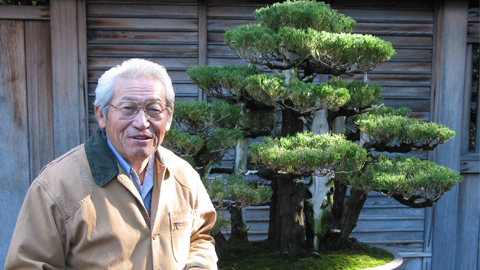The Huntington’s blog takes you behind the scenes for a scholarly view of the collections.
Bonsai Master
Posted on Thu., March 24, 2011 by
This weekend, the California Bonsai Society presents its 54th annual show at The Huntington. In anticipation of the event, we're running an article that originally appeared in the Calendar back in March-April 2004.
When Ben Oki first saw a bonsai tree as a curious youngster of six, he asked his father what bonsai was. "It's something people do when they retire," his father explained. Luckily for the world of horticulture, Oki didn't wait that long to start.
The curator of the bonsai collection at The Huntington, Oki is one of the world's leading masters of the art of bonsai. Trained under the tutelage of legendary master John Naka, Oki has devoted more than four decades to the art and has received so many honors as a teacher himself that several prestigious awards bear his name, including the Ben Oki International Design Award sponsored by the Bonsai Clubs International.
On a recent stroll through the Bonsai Court, where dozens of outstanding examples of bonsai are displayed year round, Oki talked about his craft. Behind him, a miniature camellia tree covered with pink flowers was responding to the same seasonal call as its full-sized counterparts in the Japanese Garden. Oki pointed out one of his favorite trees, a California juniper grown from a half-dead stump estimated to be more than 350 years old. Its rebirth as a bonsai started 50 years ago. A strong and healthy trunk now curves gracefully around the bleached white bones of the dead wood. Its vigorous branches extend skyward.
For the philosopher, bonsai is often said to symbolize the harmony between man and nature. But its primary appeal, Oki believes, is more literal than symbolic. "It's relaxing," he explains, with characteristic simplicity. "It's enjoyable to view." And judging from the passion he devotes to this lifelong pursuit, there are few more satisfying forms of creative expression.
The word bonsai, pronounced "BONE-sigh," literally means a tree planted in a pot. The chosen specimen can be reclaimed from nature, like the juniper stump, but trees can also be grown from seeds or cuttings. Japanese black pine, maples, elms, junipers, ginkgos, camellias, and flowering crabapples are popular choices, but other trees are also suitable. Over a period of years or decades, the trees are painstakingly pruned to stimulate growth and trained with wire to shape branches and trunks. The goal is to achieve naturalistic or stylized beauty on a small scale. Given proper care, bonsai can live for hundreds of years.
Perhaps the reason why the appeal of bonsai keeps growing is that it can't be experienced in a hurry. It may well be the perfect antidote for the fast pace of modern life. Bonsai teaches us patience, it requires nurturing, and it asks for a commitment that often lasts a lifetime. For Ben Oki, that commitment extends to teaching...and to learning. And he is in no hurry to finish.
"People call me master, but I'm still a beginner," he says. "Every day with bonsai is the beginning of the day."
The bonsai show takes place in Friends' Hall this Saturday and Sunday, March 26 & 27, from 10:30 a.m. to 4:30 p.m. Traditional trees such as Japanese black pine and California juniper will be displayed alongside outstanding examples of non-traditional bonsai.
Lisa Blackburn is communications coordinator at The Huntington.

